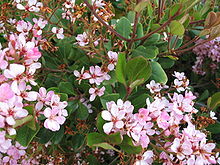Rhaphiolepis
| Rhaphiolepis | |
|---|---|
 |
|
| Rhaphiolepis indica in flower | |
| Scientific classification | |
| Kingdom: | Plantae |
| (unranked): | Angiosperms |
| (unranked): | Eudicots |
| (unranked): | Rosids |
| Order: | Rosales |
| Family: | Rosaceae |
| Subfamily: | Amygdaloideae |
| Tribe: | Maleae |
| Subtribe: | Malinae |
| Genus: |
Rhaphiolepis Lindl. |
| Species | |
|
About fifteen species, including: |
|
About fifteen species, including:
Rhaphiolepis ferruginea
Rhaphiolepis fragrans
Rhaphiolepis indica
Rhaphiolepis integerrima
Rhaphiolepis kerrii
Rhaphiolepis lanceolata
Rhaphiolepis major
Rhaphiolepis salicifolia
Rhaphiolepis umbellata
Rhaphiolepis (/ˌræfiˈɒlᵻpɪs/ or /ˌræfioʊˈlɛpᵻs/;) is a genus of about fifteen species of evergreen shrubs and small trees in the family Rosaceae, native to warm temperate and subtropical eastern and southeastern Asia, from southern Japan, southern Korea and southern China south to Thailand and Vietnam. In searching literature it is well to remember that the name commonly is misspelt "Raphiolepsis". The genus is closely related to Eriobotrya (loquats), so closely in fact, that members of the two genera have hybridised with each other; for example the "Coppertone loquat" is a hybrid of Eriobotrya deflexa X Rhaphiolepis indica. The common name hawthorn, originally specifically applied to the related genus Crataegus, now also appears in the common names for some Rhaphiolepis species. For example, Rhaphiolepis indica often is called "Indian hawthorn", and Rhaphiolepis umbellata, "Yeddo hawthorn".
...
Wikipedia
